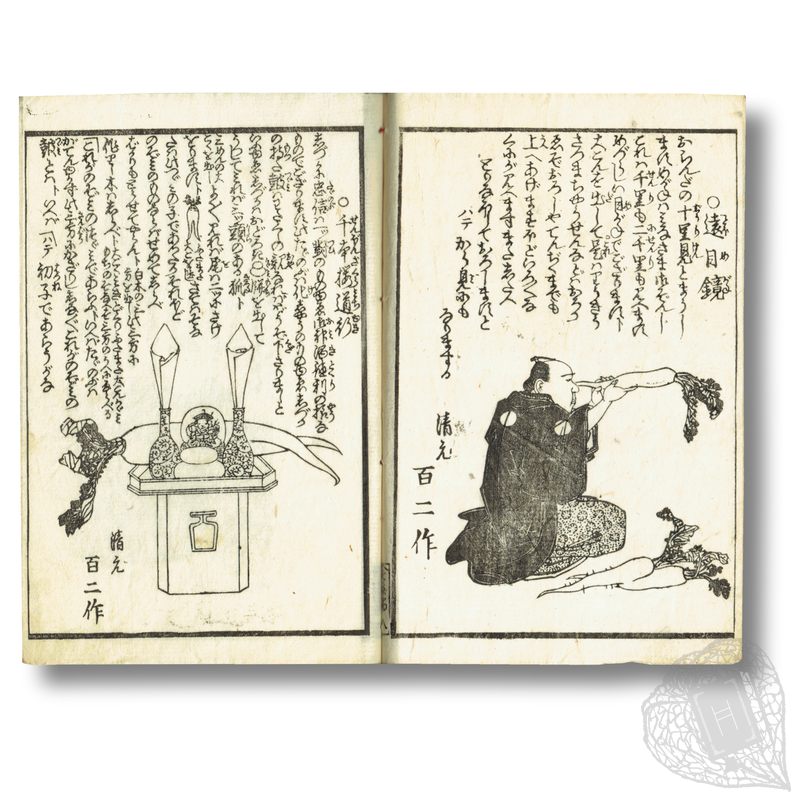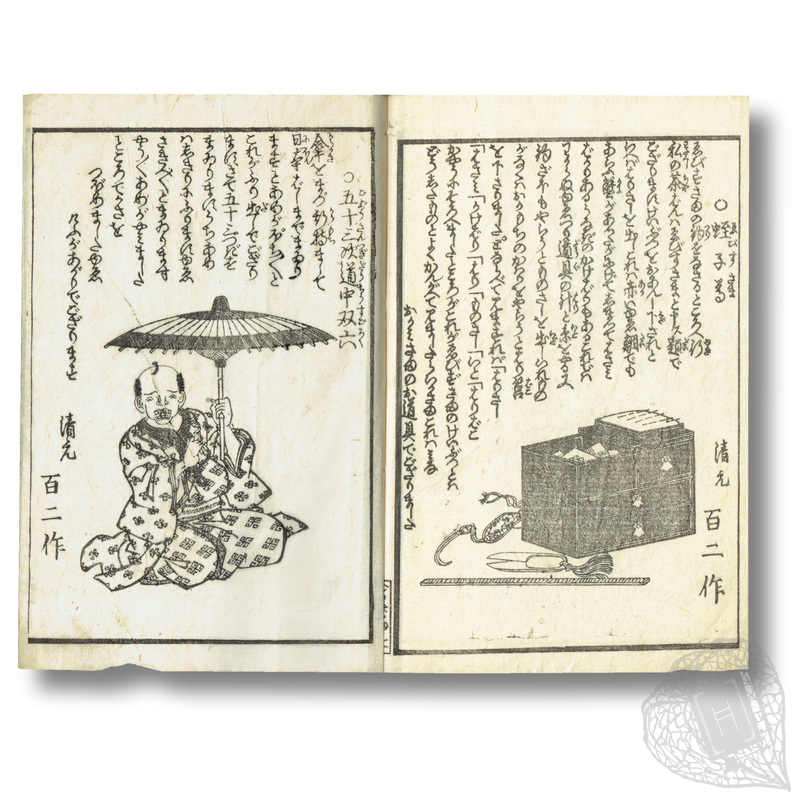Classic Illustrated Books Modern Art and Design Books Translations of Western Texts Japanese Literature Prints and Ephemera Western Books Photo Books Paintings & Scrolls Australia & New Zealand Others
Australia New Zealand Antarctica Japan Korea China Other
Edo Period [1603-1853] Bakumatsu Period [1853-1868] Meiji Period [1868-1912] Taishō Period [1912-1926] Shōwa Period [1926-1989]
Share this book on...

Hesochaban (Absurd Farces)
 ENQUIRE ENQUIRE |
Hesochaban ["Absurd Farces"]
Ippitsuan [Keisai, Eisen] [selections by]; [Keisai], Eisen [illustrated by].
Nihonbashi, [Tōkyō]: Kawaguchi Uhē, Kōka 3 [1846].
A selection of abridged chaban (skits or farces) recorded and illustrated by the ukiyo-e artist Keisai Eisen (1790-1848), who saw the pieces performed in person. Dylan McGee (2010) provides a synopsis of one of the skits in the work:
"At their most elemental, chaban pieces could be little more than riddle-like addresses to the audience, with minimal basis for dramatic interpretation. Heso chaban (臍茶番 Chaban Boiled in the Belly Button, 1846) documents an example of such a skit, whose dai is Tōmegane (遠目鏡 Telescope). According to the performance notes, the performer begins by describing the titular object and its wondrous power to enable the viewer to see distances of one and two-thousand ri. Then, midway through the monologue, the performer takes out a daikon radish, holding it up to his eye in the manner of a telescope as he delivers the following lines: “Here I see Ryūkyū, Satsuma, and Chōsen (Korea). Then, as I direct my telescope upwards, I can see various countries like Ezo (Hokkaidō), Oroshiya (Russia), and Tenjiku (India).” Despite an instance of wordplay involving the old Japanese name for “Russia” (Oroshiya) and the popular condiment “grated daikon” (daikon oroshi), the humor of this piece appears to derive from the obvious visual mitate inherent in its main prop—that is, in the absurd replacement of a daikon radish for a telescope. According to the performance notes, after this piece was performed, the actor would withdraw from the stage, leaving the keibutsu behind. Then the recipient of the keibutsu would be determined by drawing lots."
The work is self-identified as the "first selection", but no other selections were traced in Japanese library databases. Hesocha, meaning 'ridiculous' or 'absurd', means 'bellybutton tea' when translated literally. A fabulous hanashi-bon predating by at least a decade the satirical newspapers and magazines considered by Adam Kern to be one of the progenitors of modern manga. No copies traced in OCLC.
One four-hole-bound (yotsumetoji) volume, complete, on double leaves, traditional East Asian binding style (fukurotoji). Original upper wrapper, lightly soiled. Small hole to presumed original lower wrapper. Leaves lightly creased. 10 leaves. 17.7 x 12 cm.
❧ McGee, Dylan. "The History and Performance Aesthetics of Early Modern Chaban Kyōgen". Early Modern Japan: An Interdisciplinary Journal 18 (2010), 126-135.
# 240203-06


• Ask a question about this item >
Classic Illustrated Books Modern Art and Design Books Translations of Western Texts Japanese Literature Prints and Ephemera Western Books Photo Books Paintings & Scrolls Australia & New Zealand Others
Australia New Zealand Antarctica Japan Korea China Other
Edo Period [1603-1853] Bakumatsu Period [1853-1868] Meiji Period [1868-1912] Taishō Period [1912-1926] Shōwa Period [1926-1989]
Share this book on...













